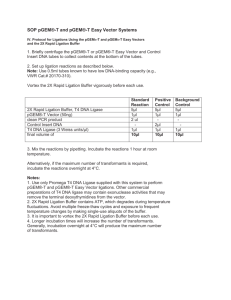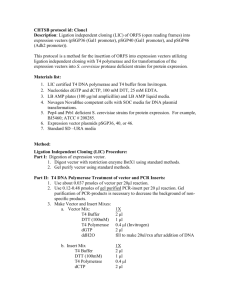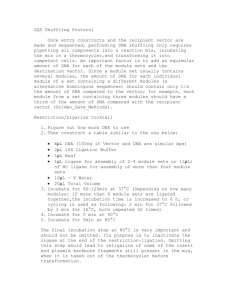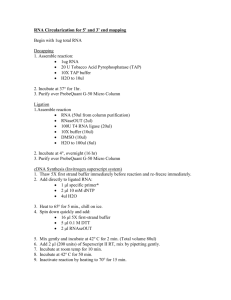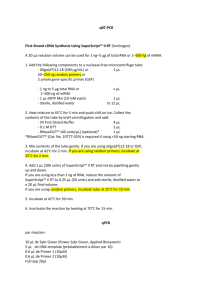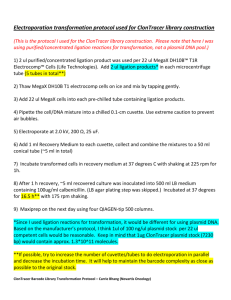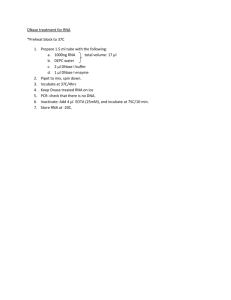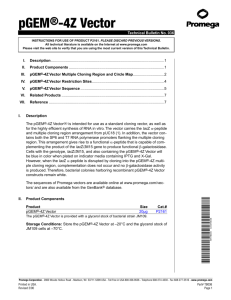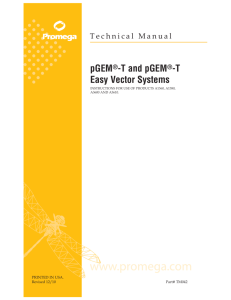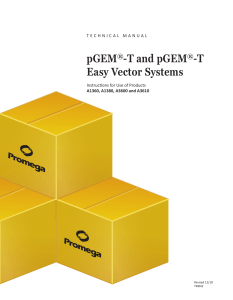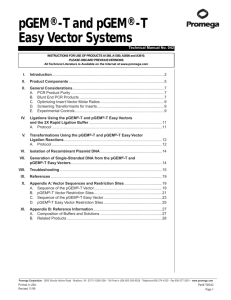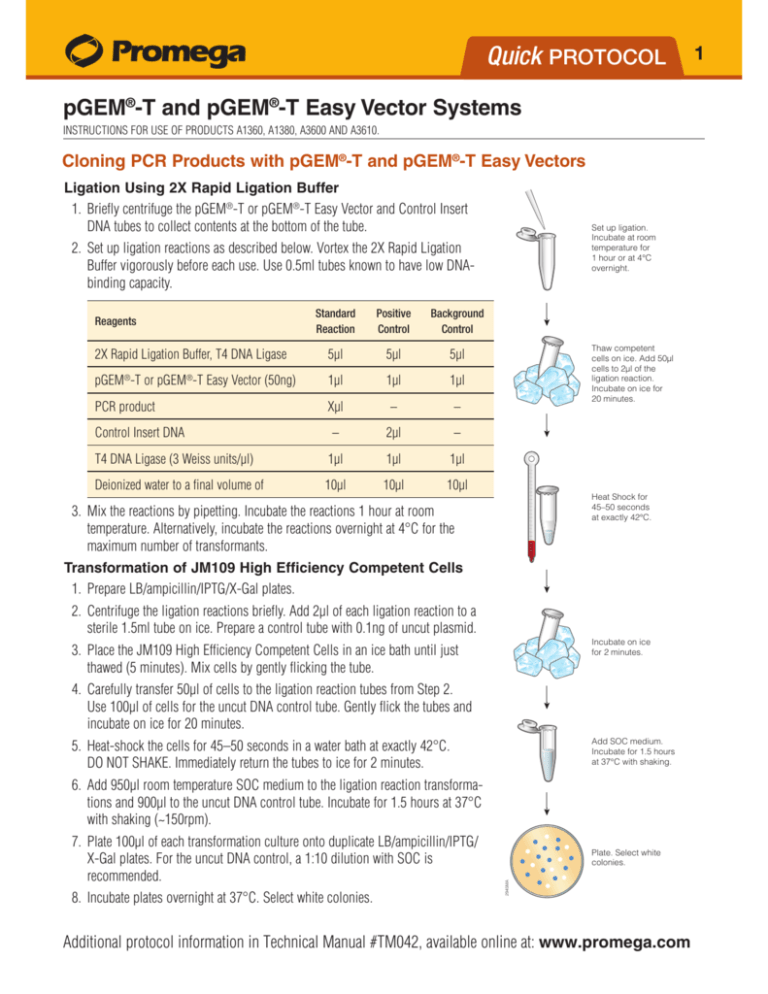
Quick PROTOCOL
pGEM®-T and pGEM®-T Easy Vector Systems
INSTRUCTIONS FOR USE OF PRODUCTS A1360, A1380, A3600 AND A3610.
Cloning PCR Products with pGEM®-T and pGEM®-T Easy Vectors
Ligation Using 2X Rapid Ligation Buffer
1. Briefly centrifuge the pGEM®-T or pGEM®-T Easy Vector and Control Insert
DNA tubes to collect contents at the bottom of the tube.
Set up ligation.
Incubate at room
temperature for
1 hour or at 4°C
overnight.
2. Set up ligation reactions as described below. Vortex the 2X Rapid Ligation
Buffer vigorously before each use. Use 0.5ml tubes known to have low DNAbinding capacity.
Standard
Reaction
Positive
Control
Background
Control
2X Rapid Ligation Buffer, T4 DNA Ligase
5µl
5µl
5µl
pGEM®-T or pGEM®-T Easy Vector (50ng)
1µl
1µl
1µl
PCR product
Xµl
–
–
–
2µl
–
T4 DNA Ligase (3 Weiss units/µl)
1µl
1µl
1µl
Deionized water to a final volume of
10µl
10µl
10µl
Reagents
Control Insert DNA
Thaw competent
cells on ice. Add 50µl
cells to 2µl of the
ligation reaction.
Incubate on ice for
20 minutes.
Heat Shock for
45–50 seconds
at exactly 42°C.
3. Mix the reactions by pipetting. Incubate the reactions 1 hour at room
temperature. Alternatively, incubate the reactions overnight at 4°C for the
maximum number of transformants.
Transformation of JM109 High Efficiency Competent Cells
1. Prepare LB/ampicillin/IPTG/X-Gal plates.
2. Centrifuge the ligation reactions briefly. Add 2µl of each ligation reaction to a
sterile 1.5ml tube on ice. Prepare a control tube with 0.1ng of uncut plasmid.
Incubate on ice
for 2 minutes.
3. Place the JM109 High Efficiency Competent Cells in an ice bath until just
thawed (5 minutes). Mix cells by gently flicking the tube.
4. Carefully transfer 50µl of cells to the ligation reaction tubes from Step 2.
Use 100µl of cells for the uncut DNA control tube. Gently flick the tubes and
incubate on ice for 20 minutes.
Add SOC medium.
Incubate for 1.5 hours
at 37°C with shaking.
5. Heat-shock the cells for 45–50 seconds in a water bath at exactly 42°C.
DO NOT SHAKE. Immediately return the tubes to ice for 2 minutes.
6. Add 950µl room temperature SOC medium to the ligation reaction transformations and 900µl to the uncut DNA control tube. Incubate for 1.5 hours at 37°C
with shaking (~150rpm).
8. Incubate plates overnight at 37°C. Select white colonies.
Plate. Select white
colonies.
2945MA
7. Plate 100µl of each transformation culture onto duplicate LB/ampicillin/IPTG/
X-Gal plates. For the uncut DNA control, a 1:10 dilution with SOC is
recommended.
Additional protocol information in Technical Manual #TM042, available online at: www.promega.com
1
Quick PROTOCOL
2
pGEM®-T and pGEM®-T Easy Vector Systems
INSTRUCTIONS FOR USE OF PRODUCTS A1360, A1380, A3600 AND A3610.
pGEM®-T Vector Circle Map and Sequence Reference Points
pGEM®-T Vector Sequence reference points:
Xmn I 1994
Nae I
2692
Sca I 1875
➞
T7
f1 ori
Amp r
pGEM®-T
Vector
Apa I
Aat II
Sph I
BstZ I
Nco I
Sac II
lacZ
T
T
(3000bp)
0356VA04/3A
Spe I
Not I
BstZ I
Pst I
Sal I
Nde I
Sac I
Bst X I
Nsi I
➞
ori
SP6
1 start
14
20
26
31
37
46
55
62
62
73
75
82
94
103
112
126
T7 RNA Polymerase transcription initiation site
1
multiple cloning region
10–113
SP6 RNA Polymerase promoter (–17 to +3)
124–143
SP6 RNA Polymerase transcription initiation site
126
pUC/M13 Reverse Sequencing Primer binding site
161–177
lacZ start codon
165
lac operator
185–201
-lactamase coding region
1322–2182
phage f1 region
2365–2820
lac operon sequences
2821–2981, 151–380
pUC/M13 Forward Sequencing Primer binding site 2941–2957
T7 RNA Polymerase promoter (–17 to +3)
2984–3
pGEM®-T Easy Vector Circle Map and Sequence Reference Points
pGEM®-T Easy Vector Sequence reference points:
Xmn I 2009
Amp r
pGEM®-T Easy
Vector
(3015bp)
1473VA05/6A
ori
lacZ
T
T
T7
Apa I
Aat II
Sph I
BstZ I
Nco I
BstZ I
Not I
Sac II
EcoR I
Spe I
EcoR I
Not I
BstZ I
Pst I
Sal I
Nde I
Sac I
Bst X I
Nsi I
➞
f1 ori
➞
Nae I
2707
Sca I 1890
SP6
1 start
14
20
26
31
37
43
43
49
52
64
70
77
77
88
90
97
109
118
127
141
T7 RNA Polymerase transcription initiation site
1
multiple cloning region
10–128
SP6 RNA Polymerase promoter (–17 to +3)
139–158
SP6 RNA Polymerase transcription initiation site
141
pUC/M13 Reverse Sequencing Primer binding site
176–197
lacZ start codon
180
lac operator
200–216
-lactamase coding region
1337–2197
phage f1 region
2380–2835
lac operon sequences
2836–2996, 166–395
pUC/M13 Forward Sequencing Primer binding site 2949–2972
T7 RNA Polymerase promoter (–17 to +3)
2999-3
Ordering and Technical Information
www.promega.com • Phone 608-274-4330
Toll free in USA 800-356-9526 • Fax 608-277-2601
©2000–2013 Promega Corporation. All Rights Reserved.
Printed in USA. Revised 12/13. Part# 9FB033

